What’s the best trolling spread? No simple answer to this question exists. When deciding which tackle and baits to use and where to position them in the wake, charter captains must consider target species, sea conditions, and the skill of crew and anglers, among other factors.
To hedge their bets, savvy skippers also set out spreads that maximize chances for hookups by attracting the widest possible variety of pelagics in a given situation. For example, late summer off North Carolina typically offers shots at gamesters ranging from 15-pound dolphin to 500-pound blue marlin. In the South Pacific, anglers trolling off Tonga can see five different species of billfish in a day, along with tuna and wahoo.
Flexibility and willingness to adapt to changing conditions prove crucial to trolling success. Every seasoned pro interviewed for this article stressed that, yes, he has a few favorite lures and spreads — but if something doesn’t seem to work on a certain day, he won’t hesitate to change the setup. Look at these “standard” spreads as guidelines (not hard-and-fast rules) for deploying baits in different situations. Then tweak as necessary to fit your boat’s outriggers, crew and conditions.
Find diagrams of each spread below.
Northeast Canyons Trolling Spread
Boats leaving ports in New Jersey, Delaware or Maryland normally run 60 to 100 miles to fish offshore canyons where a pelagic variety awaits the baits. “Mixed spreads are quite popular in the Northeast because in a day’s trolling anglers might raise blue marlin, white marlin, bigeye and yellowfin tuna. Crews usually pull both natural baits and artificial lures in the same pattern,” says Lee Green of Stalker Outfitters (800-251-8263) in Westhampton Beach, New York.
Green recommends cleating off a dredge at the transom. “Put the dredge where you can see it; otherwise it does no good. On a flybridge boat, it shouldn’t be more than 35 feet back,” he says. On the other side of the spread, he runs a large plunger lure as a bridge teaser.
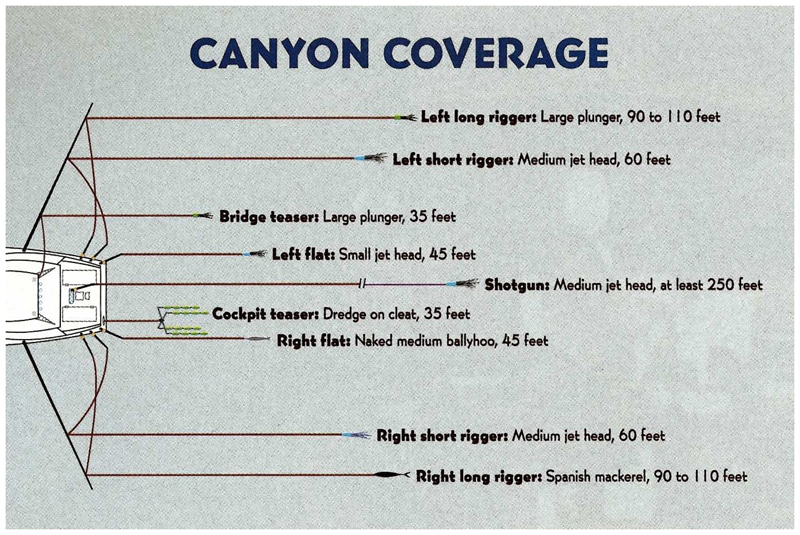
The flat-line baits, deployed on 30-pound tackle, ride about 10 feet behind each teaser. Here, Green uses a small jet head or naked medium ballyhoo in hopes of provoking whitey. “We run these baits close to the boat because of the typical difficulty in hooking white marlin. Getting bites in tight puts us in better position to hook up,” he says. In addition to the flat-line baits in the water, a ballyhoo pitch bait on 30-pound remains at the ready in the cockpit.
“The short-rigger baits usually target tuna, so we use medium jet heads on 50-wides and place them about 60 feet back of the transom,” Green says. He points out that when tuna run thick, most crews stow their 30s and put out jets on 50-wides in the flat-line spots as well. On the other hand, when the white marlin bite gets going strong, it’s better to pull ballyhoo on 30-pound outfits in all flat-line and short-rigger slots.
With blue marlin in his sights, Green puts the big guns — in this case, 80-wides — in both long-rigger positions. Bait choice comes down to personal preference, though most anglers opt for Spanish mackerel or large plunger-type lures.
As a finishing touch, a medium jet head on a 50-wide rides shotgun at least 250 feet back to pick up any stray tuna.
Carolina Catch-All
“I’m ready to catch whatever’s willing to bite!” says Capt. Richard Budalich, a freelance skipper who runs private and charter boats in North Carolina, Florida and the Caribbean. He especially likes fishing out of Morehead City, North Carolina, for the grab-bag possibilities. “Morehead has an excellent run of tuna in April and May,” he says. “After that, we change from focusing exclusively on yellowfin to trying to catch everything from dolphin to blue marlin.”
As bridge teasers, Budalich often deploys a dredge and another personal favorite. “I’m particularly fond of my Ilander teaser: a chain of four standard blue Ilander lures followed by an Express Jet with a mullet or mackerel stuffed inside it,” he says.
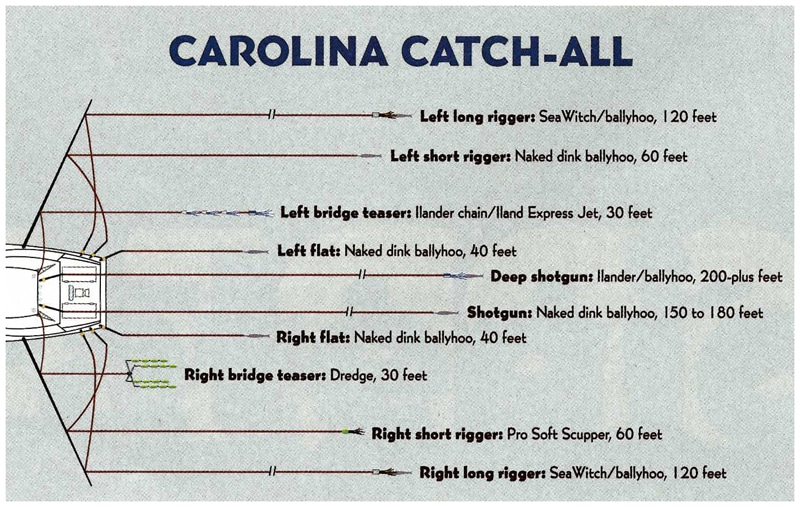
Dink ballyhoo on 20- or 30-pound gear occupy the flat-line positions, about 10 feet behind each teaser. These baits may tempt anything from dolphin to sailfish to white marlin. “They work like pitch baits, but they’re already in the water,” Budalich says. “I like to keep both flat-line baits the same distance back because fish often come up on one bait, take a whack at it and shoot right across the spread to grab the other.”
Short-rigger baits slip in about 20 feet beyond the flat-liners. Here, Budalich might run a dink bally on 20- or 30-pound tackle or a Pro Soft Scupper or other chugger head on 80-pound. “I always put my larger lures on heavy tackle in the short-rigger spot because that’s where I seem to get the most blue marlin bites,” he says.
Another all-time favorite North Carolina bait, the SeaWitch/ballyhoo combo, gets into the pattern’s long-rigger spots. Budalich sets these about 120 feet back of the transom using 50-pound outfits because these baits, he says, “could get hit by anything from 80-pound yellowfin to 100-pound wahoo to blue marlin ranging from 100 pounds and up.”
A “shortgun” bait (naked dink ballyhoo on 30-pound tackle) trails 150 to 180 feet behind the transom, followed by a deeper shotgun bait at least 200 feet back. This caboose usually consists of an Ilander/ballyhoo combo on 50-pound gear.
Tonga Tactics
“Within 10 minutes of our harbor, we reach underwater cliffs that go from 300 to 3,000 feet and extend for 5 miles,” says Capt. Steve Campbell of Ika Lahi Lodge in Tonga. “On any given day we can encounter blue, black and striped marlin, sailfish, spearfish, wahoo, mahimahi, yellowfin and dogtooth tuna.”
Campbell takes advantage of this South Pacific smorgasbord with a trolling spread that features a mix of heavy and light tackle and large and small lures. He also keeps pitch baits at the ready, rigged on several different line-class outfits.
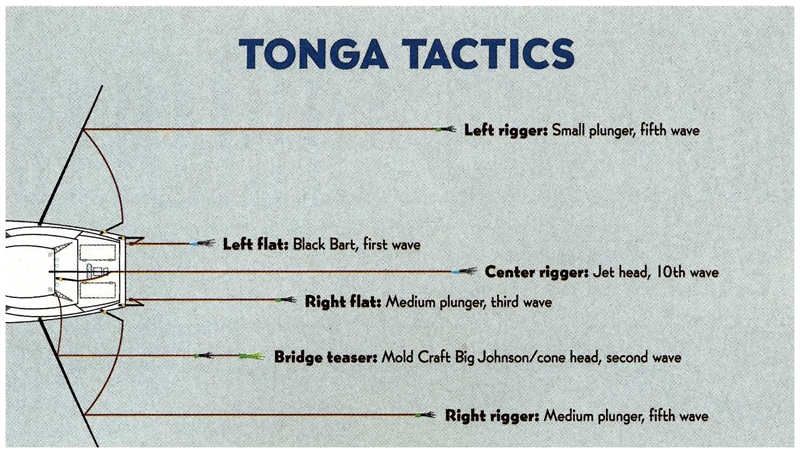
Thinking big blues, Campbell sets out a Mold Craft Big Johnson/cone-head lure combo as a bridge teaser on the right side’s second wave. A medium-sized plunger on 80-pound gear rides close behind on the third wave, with the line clipped to the transom.
He then puts out a giant killer on 130-pound tackle on the left side’s first wave. “I’m a fan of Black Bart lures and use their larger models, such as Marlin Candy, Hawaiian Breakfast and Super Plunger,” he says. He clips the line to the transom and keeps the lure close to reduce reaction time after a hookup. “We have to get on top of big fish quickly; otherwise, they can cut the line on the steep drop-off,” says Campbell.
An 80-pound outfit pulls a medium plunger-style lure on the right rigger, set on the fifth wave. Or when targeting yellowfin or mahimahi, Campbell puts out a smaller jet head on 50-pound tackle. “Of course, when we do that, Murphy’s Law sends a big blue to eat that lure,” he says with a grin.
The left-rigger lure, also on the fifth wave, usually consists of a small plunger on 50-pound gear. Ten waves back, a jet head on 50-pound picks up any fish that may not want to rush into the heart of the spread. A center rigger keeps this line up and out of the way.
“In flat seas I keep my spread tight to the transom. When it gets rough, I space out the lures because I do a lot of sharp turns when working the drop-off,” says Campbell.
Florida Free-for-All
Spring and fall bring a pelagic potpourri within range of boats working Florida’s Space Coast. You’ll find Capt. Scott Goodwin (321-228-0048; scott@fishtrap.com) chartering out of Port Canaveral, where he targets king mackerel, dolphin, wahoo, sailfish and the occasional blackfin tuna.
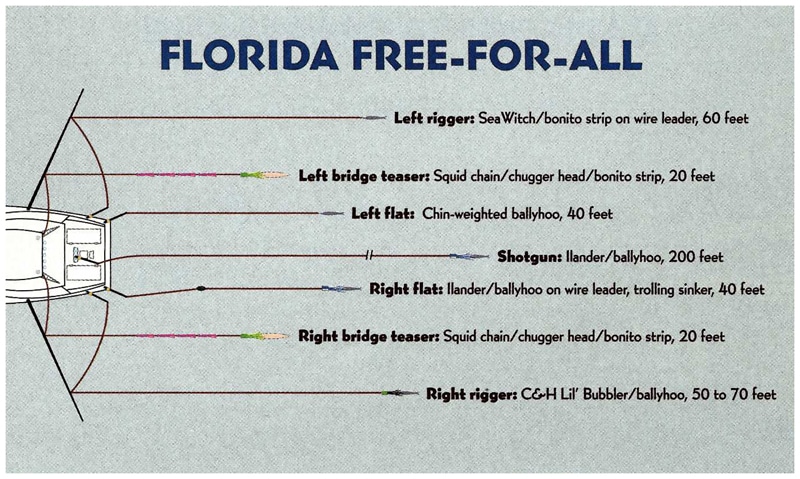
Goodwin usually deploys a daisy-chain teaser (8- or 10-inch squids trailed by a chugger-lure/bonito-strip combo) from each side of the bridge, dropping them back about 20 feet. After that, he sets out the flat lines. On the right goes a 9/0 reel loaded with 100-pound braid, rigged with a 24-ounce trolling sinker, 40 feet of 300-pound mono and an Ilander/ballyhoo combo on #9 wire. “This is a meat rod,” Goodwin admits. “We put it out with wahoo in mind.”
The left flat-line bait consists of a naked, chin-weighted ballyhoo on 30-pound gear and 50-pound mono leader. Positioned about 40 feet back, this bait draws strikes from just about every species Goodwin comes across. It can also be reeled up and offered to fish on the teaser.
A ballyhoo behind a small SeaWitch or C&H Lil’ Bubbler, also on 30-pound, rides 50 to 70 feet back in the right-rigger slot. About 60 feet back on the left rigger, Goodwin runs 30-pound tackle and #7 wire leader with a SeaWitch/bonito-strip bait. “I really like that strip bait,” he says. “It’s rather small, so dolphin can easily inhale it. And it’s tough, so sailfish can take multiple shots at it until they get hooked.”
Finally, another 30-pound outfit pulls an Ilander/ballyhoo or Iland Sailure/bonito strip shotgun bait on a #9 wire leader. “That bait goes way back, probably 200 feet. It accounts for a lot of wahoo but will catch other species as well,” says Goodwin.
California Searching
Albacore, yellowfin and bluefin tuna stay on the move — and so do Southern California anglers in pursuit of these hard-fighting, delicious game fish. “We usually troll when searching for schools of tuna and albacore,” says Andrew Alvarez of Melton Tackle (800-372-3474) in Anaheim, California.
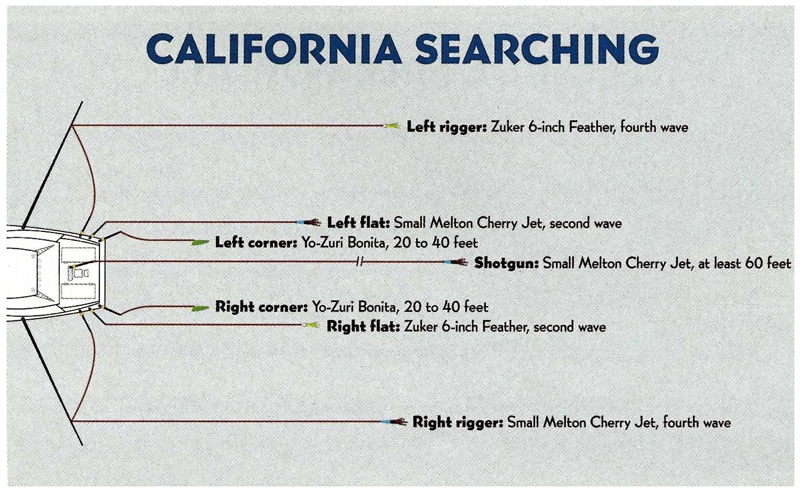
Boats leaving San Diego ports typically make 60- to 100-mile treks to reach banks and temperature breaks holding albies that average 30 pounds but may grow to 50. With luck, they sometimes also come across bluefin ranging from 30 to 150 pounds. “Trolling is the best way to locate fish,” Alvarez explains. “Once we get a trolling bite, we stop and throw out live baits to hold tuna near the boat. If we don’t get any bites within a few minutes, it’s back to trolling to find another school.”
Alvarez recommends Zuker 6-inch Feathers and small Melton Cherry Jets, pulled on 50-pound outfits, as best-bet lures when prospecting for albacore. When he suspects bluefin are in the area, he puts an 80-pound rig at each transom corner to deploy Yo-Zuri Bonitas 20 to 40 feet back. “These lures dive deep, so they won’t tangle with the feathers and jets,” Alvarez says.
The simple, no-nonsense spread proves ideal in convincing albies to betray their presence. From the flat lines, feathers or jets ride on the second wave back. Similar lures, clipped to the riggers, run on the fourth wave. A shotgun lure goes straight down the middle, at least 60 feet back.
Guatemala KISS
Anglers in the know conjure images of high-volume sailfishing whenever anybody mentions Artmarina (305-663-3553) and Guatemala’s Pacific coast. Yes, sails can smother you here, but enough blue marlin prowl these waters to keep Capt. Brad Phillips on his toes. While designed primarily to maximize multiple-hookup opportunities afforded by pods of voracious Pacific sails, Phillips’ spread also allows anglers to capitalize on chances at any blues that pop in for a visit. “I believe in the KISS theory to avoid cockpit confusion,” Phillips says. “Never put out more baits and teasers than your crew and anglers can handle. You must maintain control of the spread.”
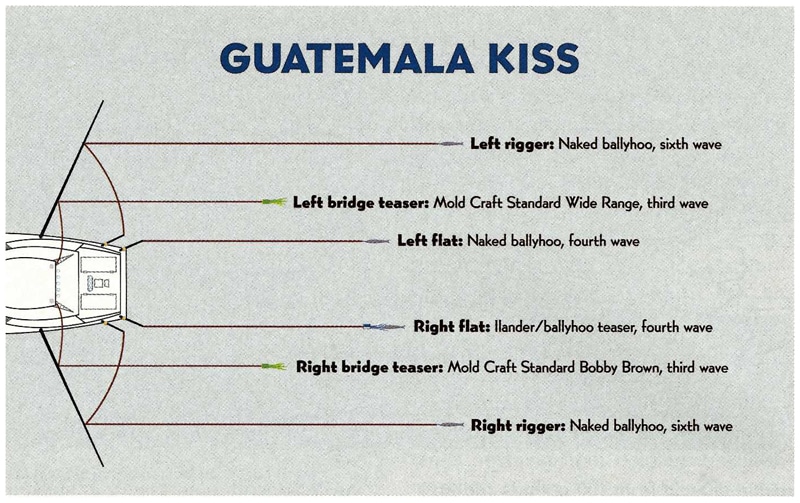
Since Pacific sails show neither fear of nor respect for sizable lures, Phillips knows he can use bridge teasers large enough to rouse a marlin’s interest without sacrificing shots at sails. He runs a Mold Craft Standard Bobby Brown on the right side and a Mold Craft Standard Wide Range on the left, both riding on the wake’s third wave. “I’ve raised fish on daisy-chain teasers but find them hard to get out of the water quickly. If you can’t snap the teaser out of the water, sails often stay on it rather than switching over to a bait,” he says. One more teaser, an Ilander/ballyhoo combination deployed on a 30-pound rod, occupies the right flat-line position on the fourth wave.
Pitch-bait rigs in the cockpit include several 20-pound rods with naked ballyhoo, ready to pluck sailfish off the teasers, and a mackerel on 50-pound for dropping back to blues.
Phillips prefers baiting sails with naked, skipping ballyhoo rigged on Eagle Claw 2004 7/0 circle hooks. He rounds out his spread with three of these baits, all on 20-pound tackle: one on the left flat (fourth wave) and two in the rigger positions (sixth wave). “I like a fairly tight spread,” he says. “If you start with a bait far back, then drop back to feed a fish, it takes longer to see if you’ve missed the bite.
If you do miss the first bite, you start a second drop-back even farther from the boat. Keeping baits in tight and beginning the drop-back process closer to the boat gives you more control.”
On days when baits seem to raise more sails than teasers, Phillips may put a ballyhoo out in place of the teaser on the right flat. Conversely, when sails seem more interested in teasers, he’ll swap one of the rigger baits for a hookless lure and tease fish in to a pitch bait.








